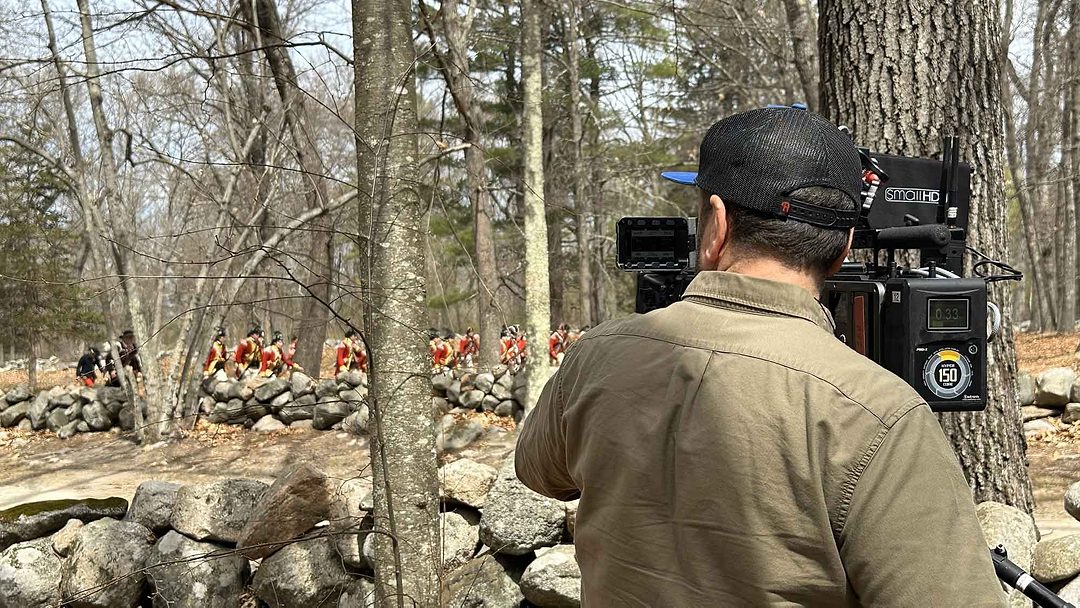The American Revolution, a new six-part, 12-hour series directed by Ken Burns, Sarah Botstein, and David Schmidt and written by Geoffrey Ward will premiere on PBS on November 16, 2025. The series examines how America’s creation turned the world upside-down. Thirteen British colonies on the Atlantic Coast rose in rebellion, won their independence, and established a new form of government that radically reshaped the continent and inspired centuries of democratic movements around the globe.
An expansive look at the virtues and contradictions of the war and the birth of the United States of America, the film follows dozens of figures from a wide variety of backgrounds. Viewers will experience the war through the memories of the men and women who experienced it: the rank-and-file Continental soldiers and American militiamen, Patriot political and military leaders, British Army officers, American Loyalists, Indigenous soldiers and civilians, enslaved and free African Americans, German soldiers in the British service, French and Spanish allies, and various civilians living in North America, Loyalist as well as Patriot, including many made refugees by the war. The American Revolution was a war for independence, a civil war, and a world war. It impacted millions – from Canada to the Caribbean and beyond. Few escaped its violence. At one time or another, the British Army occupied all the major population centers in the United States – including New York City for more than seven years.
Discover Concord magazine had the privilege of speaking with the filmmakers about their experience here in the Concord and Lexington area and what it meant to them to film such an important documentary about the war that would launch the United States of America into being.

Filmmaker Ken Burns
“The American Revolution has always been surrounded by myth that keeps us from seeing the real picture,” said Ken Burns. “The story of the birth of this country is at once devastating and inspiring. It was a bloody civil war that divided families and communities, displaced native nations, both challenged and protected the institution of slavery, while also proclaiming the noblest aspirations of humankind.”
“Our film tells the remarkable history of the people who lived through the American Revolution, their everyday concerns, and their hopes, fears, and failings,” said Sarah Botstein co-director of the series. “It’s a surprising and deeply relevant story, one that is hugely important to understanding who we are as a country and a people. The Revolution changed how we think about government – creating new ideas about liberty, freedom, and democracy.”
“The Revolution was eight years of uncertainty, hope, and terror, a brutal war that engaged millions of people in North America and beyond and left tremendous loss in its wake,” said David Schmidt, co-director and co-producer of the documentary. “At the same time, the Revolution also changed how Americans thought about themselves, their government, and what they could achieve. The United States that emerged from the war was a nation few could have imagined before the shooting began in April 1775.”

Battle of Bunker Hill. Painting by Alonzo Chappel, 1859.
According to the filmmakers, the American Revolution is often pristine in our collective memories. But that’s not the reality of the conflict. We want it to be just great men thinking great thoughts in Philadelphia, and it is largely about that. But this is a film called The American Revolution. So it meant they wanted to tell the stories of what happened at the Boston Massacre, on Lexington Green, at the North Bridge in Concord, at Bunker and Breed’s Hill and beyond.
They describe the American Revolution as a symphony in three movements. From New England it moves to the Mid-Atlantic states. And then it moves to the southern states and ends in an incredibly bloody and dramatic conclusion. “As filmmakers, we had to be faithful to that and make sure that people who are unfamiliar with the stories beyond the journey from Lexington and Concord to the surrender at Yorktown, have a chance to understand the many other battles and the full narrative through the stories of the people who lived those moments.”
Burns and his team also emphasized that the American Revolution was essentially a World War that involved more than two dozen nations - European as well as Native American. The Native American story is almost never told. There were those who fought with the British, those who tried desperately to remain neutral, and those who fought on the side of the Patriots. In fact, there is a Native American woman in Massachusetts who lost five sons fighting for the Patriot cause – can you imagine? These are the kinds of stories they spent nine years collecting to show what an intimate and complicated story this American Revolution truly is.

Cinematographer Buddy Squires on-location
The Concord and Lexington Experience
I asked Ken Burns and his team about their experiences here in Concord and Lexington while filming for the documentary.
“My first wife, who passed away, and her family were from Lexington, so I’ve spent a lot of time there,” said Burns. “I taught at Concord Academy in the summer of ‘72. This place holds stories. And now we are trying to bring back the ghosts who are there through paintings, through following reenactors, through drawings, and through going to the now quiet places like the North Bridge.”
“Filming that bridge, just as it is today, is so powerful. Just filming there in the early hours with no tourists, no residents, just alone… and you have to imagine and pour into it what happens to Isaac Davis when somebody on the British side says “fire,” and someone shoots and kills him.”
“Over many years, I walked through Lexington and Concord, and along the Battle Road in Minute Man National Historical Park so many times. It’s so spectacular to get out and walk and see how carefully the area and the witness houses along the route have been preserved and protected over the years. Often, I would think about the British marching there and then high-tailing it back - and what it would be like for them to understand that they were in a guerrilla war. I mean, their casualties were horrific and then even worse at Bunker and Breed’s Hill.”
“How do you capture the horror of an angry and harrowed British Army racing back to Boston and stopping to break through the doors of houses in nearby Menotomy (now called Arlington) and killing everyone inside – with such violence that blood spilled over the doorway? We don’t always think of the American Revolution as the military and vicious war that it was.”
“You can strip away some of this mythology of the great legends we have all learned in school and then start to backfill with these complex and nuanced characters that bring the story to life. At the end of the day, we are storytellers and we’re trying to figure out how to carry as many of those stories as possible out of this big, larger story, which is our national creation myth.”

Film crew at Colonel Barrett House in Concord, MA.
“This revolution is the first time in human history that people said we want to start a revolution for the purpose of starting a country based on the idea that throughout human history, people have been subjects and we want them to be citizens. It’s a big deal. It’s one hell of a story. And it makes you proud. And it makes you angry. And makes you disappointed. And it makes you exultant that the story and the characters are complicated and nuanced.”
“There are so many complicated and very subtle dynamics to the story of the American Revolution, and you can’t either wish them away or simplify them if you’re going to dive into it. That’s why I say, I won’t work on a more important film in my life,” said Burns. “I’ve worked on films that I think are important. I hope to work on films, God willing, that are also important. But, for me, nothing will be more important than getting this story right.”
The American Revolution will make its debut November 16 – 21 at 8:00 – 10:00 pm EST (check local listings) on PBS. The full series will be available to stream beginning Sunday, November 16 at PBS.org and on the PBS App.

North Bridge
Historic Preservation Makes a Difference
“When creating such an important documentary, we stand on the shoulders of 250 years of other people’s work on this subject,” said David Schmidt, co-director of the film series. “So many historians, curators, park rangers, and people passionate about historic preservation helped make the film possible.”
“Staying right in the center, at the Colonial Inn, made it so easy to absorb what Concord really is,” he continued. “We were able to walk everywhere. We would shoot at sunrise and sunset – experiencing this beautiful place while encountering a lot of folks walking their dogs or just curious about what we were doing. It was a fun experience – and very beautiful to see the sunrise at the North Bridge.”
Megan Ruffe, co-producer on this series, oversaw the team here in Concord and Lexington. “We have to credit all the local historical societies and the rangers and stewards of history at the local level who’ve really helped maintain protected views and areas to make it feel it like you’re here in the 18th century. It made it so much easier to film,” she said.
“One aspect that was really challenging is that the time period was pre-photograph, so we had to look out for clues of what life was like in the 18th century and then figure out how to take that and translate that into footage,” Megan said. “Collaborating with local historians and stewards of preservation was vital to the success of the project. We had to rely on paintings, documents, preserved buildings, and material cultural items to help tell the story visually. The Amos Doolittle drawings were instrumental in helping us visualize what happened that day.”

(from left to right) Associate Producer Shyala Jayasinghe, Apprentice Editor Colin Costa-Walsh, MMNHP Park Ranger Bill Fuchs, Co-Producer Megan Ruffe, and Cinematographer Antionio Rossi at the reenactment event.
| ©Graham Deneen“At Minute Man National Historical Park, we worked with a ranger there who helped us get the appropriate material culture in the space when we were filming at the Hartwell Tavern. That was amazing, because the park is so visually protected from modern sight lines. When you walk from the parking area to the path leading to the tavern, the park opens up to the historically preserved Battle Road, the Hartwell Tavern, and this wooden fence that runs along the road exactly as it did back then. These things were obviously there in April 1775 and it’s kind of eerie how much the experience takes you right back in time.”

A still from the series shot by Chris Ewers at the Hartwell Tavern.
| ©Chris Ewers/ Florentine Films“Another place that was special was the Colonel James Barrett house, which was recently restored. The park rangers let us go inside to film it right before they brought all the furniture back in. So, we were in this empty, beautifully restored house and it was so well done and the detailing in it was so specific to the region that it took me right back to 1775. I know that for the people who worked on the restoration, it was a real labor of love. It’s very cool that we got to experience it.”


